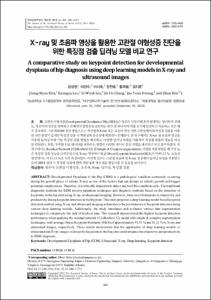Department of Electrical Engineering and Computer Science
Medical Acoustic Fusion Innovation Lab.
1. Journal Articles
X-ray 및 초음파 영상을 활용한 고관절 이형성증 진단을 위한 특징점 검출 딥러닝 모델 비교 연구
- Title
- X-ray 및 초음파 영상을 활용한 고관절 이형성증 진단을 위한 특징점 검출 딥러닝 모델 비교 연구
- Alternative Title
- A comparative study on keypoint detection for developmental dysplasia of hip diagnosis using deep learning models in X-ray and ultrasound images
- Issued Date
- 2023-09
- Citation
- 한국음향학회지, v.42, no.5, pp.460 - 468
- Type
- Article
- Author Keywords
- Developmental Dysplasia of Hip (DDH) ; Ultrasound ; X-ray ; Deep-learning ; Keypoint detection ; 영유아 고관절 이형성증 ; 초음파 ; 딥러닝 ; 특징점 검
- Keywords
- SPECKLE
- ISSN
- 1225-4428
- Abstract
-
고관절 이형성증(Developmental Dysplasia of Hip, DDH)은 영유아 성장기에 흔히 발생하는 병리학적 상태로, 영유아의 성장을 방해하고 잠재적인 합병증을 유발하는 원인 중 하나이며 이를 조기에 발견하고 치료하는 것은 매우 중요하다. 기존의 DDH 진단 방법으로는 촉진법과 X-ray 또는 초음파 영상 기반 고관절에서의 특징점 검출을 이용한 진단 방법이 있지만 특징점 검출 시 객관성과 생산성에 제한점이 존재한다. 본 연구에서는 X-ray 및 초음파 영상을이용한 딥러닝 모델 기반 특징점 검출 방법을 제시하고, 다양한 딥러닝 모델을 이용하여 특징점 검출의 성능을 비교분석하였다. 또한, 부족한 의료 데이터를 보완하는 방법인 다양한 데이터 증강 기법을 제시하고 비교 평가하였다. 본연구에서는 Residual Network 152(ResNet152) 및 Simple & Complex augmentation 기법을 적용하였을 때 가장 높은 특징점 검출 성능을 보여주었으며, X-ray 영상에서 평균 Object Keypoint Similarity(OKS)가 약 95.33 %, 초음파영상에서는 약 81.21 %로 각각 측정되었다. 이러한 결과는 고관절 초음파 및 X-ray 영상에서 딥러닝 모델을 적용함으로써 DDH 진단 시 특징점 검출에 관한 객관성과 생산성을 향상시킬 수 있음을 보여준다.
Developmental Dysplasia of the Hip (DDH) is a pathological condition commonly occurring during the growth phase of infants. It acts as one of the factors that can disrupt an infant's growth and trigger potential complications. Therefore, it is critically important to detect and treat this condition early. The traditional diagnostic methods for DDH involve palpation techniques and diagnosis methods based on the detection of keypoints in the hip joint using X-ray or ultrasound imaging. However, there exist limitations in objectivity and productivity during keypoint detection in the hip joint. This study proposes a deep learning model-based keypoint detection method using X-ray and ultrasound imaging and analyzes the performance of keypoint detection using various deep learning models. Additionally, the study introduces and evaluates various data augmentation techniques to compensate the lack of medical data. This research demonstrated the highest keypoint detection performance when applying the residual network 152 (ResNet152) model with simple & complex augmentation techniques, with average Object Keypoint Similarity (OKS) of approximately 95.33 % and 81.21 % in X-ray and ultrasound images, respectively. These results demonstrate that the application of deep learning models to ultrasound and X-ray images to detect the keypoints in the hip joint could enhance the objectivity and productivity in DDH diagnosis. Copyrightⓒ2023 The Acoustical Society of Korea. This is an Open Access article distributed under the terms of the Creative Commons. Attribution Non-Commercial License which permits unrestricted non-commercial use, distribution, and
reproduction in any medium, provided
the original work is properly cited.
- Publisher
- 한국음향학회
- Related Researcher
-
-
Chang, Jin Ho
- Research Interests Biomedical Imaging; Signal and Image Processing; Ultrasound Imaging System; Ultrasound Transducer; Photoacoustic Imaging
-
- Files in This Item:
-
 기타 데이터 / 2.01 MB / Adobe PDF
download
기타 데이터 / 2.01 MB / Adobe PDF
download



